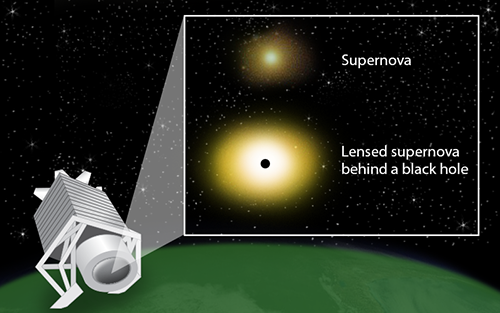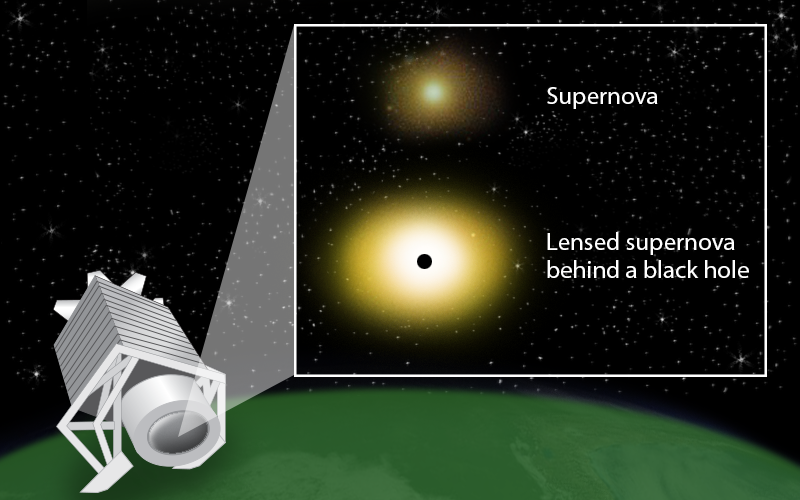Supernova Study Dampens Dark Matter Theory
Black holes are one of the oldest candidates for dark matter—the unidentified “stuff” that underpins galaxies and makes up 85% of the matter in the Universe. But whether the total mass of black holes is sufficient to account for all the dark matter is unclear. A new analysis of supernovae makes this possibility seem very unlikely [1]. A black hole of sufficient mass passing in front of a supernova should act as a magnifying lens and make the star appear brighter, allowing the black hole to be spotted. But when Miguel Zumalacárregui and Uroš Seljak from the University of California, Berkeley, searched for this effect in over a thousand supernovae, they came up empty handed. Their analysis applies to all black holes with masses greater than 0.01 times that of our Sun and indicates that such objects can account for at most 40% the Universe’s dark matter.
Stephen Hawking first proposed the idea that black holes might contain the Universe’s missing matter in 1974. The idea quickly attracted the attention of other physicists, as it didn’t require some, as yet, undiscovered particle. Black holes can form when massive stars implode, but there haven’t been enough such stars to account for dark matter. However, current theories suggest that huge numbers of black holes could have formed in the early Universe from the gravitational collapse of dense regions of matter and that the total mass of these so-called primordial black holes could be enough to account for dark matter [2] (see accompanying Feature: Controversy Continues over Black Holes as Dark Matter). But so uncertain is this era of the Universe that our best theories make no solid prediction for the mass of primordial black holes: if they exist, they could be as light as g, roughly the same weight as an eyelash, or as heavy as a billion Suns.
Black holes that originate from a collapsed star usually have a visible “halo” of gas and debris swirling around them. However, primordial black holes, if they exist, formed before the first atoms, leaving them disc-free and completely dark. To see such a black hole, researchers therefore look for its gravitational effect on light. Previous searches for black holes via gravitational effects ruled out the existence of large numbers of primordial black holes with masses ranging from down to times that of our Sun [3, 4], restricting possible models that allow black holes to explain dark matter. Then, in 2015, the LIGO-Virgo collaboration detected the first gravitational signal from two merging black holes [5]. Their analysis indicated that the black holes they detected each had a mass more than 25 times greater than that of our Sun—heavier than the mass expected for a typical black hole formed from a dying star. The finding fueled speculation that the LIGO-Virgo collaboration had detected primordial black holes, and interest in black holes as dark matter candidates was renewed [6].
In their study, Zumalacárregui and Seljak looked for black holes using the effect of gravitational lensing, the same gravitational effect probed in previous studies. This effect arises when the path of light emitted by an object, say a star, is bent by the gravity of some other object, like a black hole, that sits between the star and Earth. The black hole acts as a lens, making the star appear brighter, with the degree of brightening depending on the black hole’s mass (Fig. 1). The previous lensing experiments searched for black-hole-brightened stars in the Magellanic Clouds—two dwarf galaxies that closely orbit the Milky Way [3, 4, 7]. The duration of the experiments made them sensitive to changes in a star’s brightness over timescales from a few minutes to five years—long enough to detect the transit of black holes with masses of up to 10 times that of our Sun.
The same approach isn’t practical for observing larger black holes, which could take a decade or more to pass by a star. Instead, Zumalacárregui and Seljak turned to lensing-induced brightening of supernovae. The variety of supernovae they observed, type 1a, are standard candles—they have an intrinsic brightness that can be determined by measuring how quickly they fade. But because of lensing, a supernova erupting fortuitously behind a passing black hole will appear brighter than expected from its fade time. Looking for artificially bright supernovae eliminates the need to wait for the black hole to transit the object, providing sensitivity to black hole masses ranging from 0.01 to several thousand times that of the Sun.
The duo analyzed the signals from over 1300 supernovae spread across most of the sky in the Northern hemisphere, finding no brighter-than-expected supernovae. Assuming different black hole abundances, they also calculated the likelihood that a black hole—in the mass range detectable in the experiment—would randomly pass between Earth and one of the supernovae in the time frame of the measurements. Based on this calculation, they conclude that the cumulative mass of these black holes can account for only 40% of dark matter.
The work of Zumalacárregui and Seljak shows that black holes with masses greater than 0.01 times that of our Sun occur in insufficient numbers to account for all the dark matter. The result, taken together with those from other experiments [8], rules out the idea that dark matter could be entirely accounted for with black holes. But the possibility remains that black holes could make up a small fraction of dark matter, with the rest coming from some other potential source like weakly interacting massive particles (WIMPs), sterile neutrinos, or axions. For this reason, experiments will continue to search for black holes. Future supernova surveys will likely further tighten the constraints placed by Zumalacárregui and Seljak on the mass and abundance of black holes in the Universe. For example, the upcoming start-up of the Large Synoptic Survey Telescope, which will be able to image the entire sky in three days, should significantly boost our ability to detect transient events, be they related to black hole lensed supernovae and stars, or something else.
This research is published in Physical Review Letters.
References
- S. Uroš and M. Zumalacárregui, “Limits on stellar-mass compact objects as dark matter from gravitational lensing of type Ia supernovae,” Phys. Rev. Lett. 121, 141101 (2018).
- M. Sasaki, T. Suyama, T. Tanaka, and S. Yokoyama, “Primordial black holes—perspectives in gravitational wave astronomy,” Class. Quantum Grav. 35, 063001 (2018).
- C. Alcock et al. (The MACHO Collaboration), “MACHO Project limits on black hole dark matter in the 1-30 solar mass range,” Astrophys. J. Lett. 550, L169 (2001).
- L. Wyrzykowski et al., “The OGLE view of microlensing towards the Magellanic Clouds - IV. OGLE-III SMC data and final conclusions on MACHOs,” Mon. Not. R. Astron. Soc. 416, 2949 (2011).
- B. P. Abbott et al. (LIGO Scientific Collaboration and Virgo Collaboration), “Observation of gravitational waves from a binary black hole merger,” Phys. Rev. Lett. 116, 061102 (2016).
- S. Bird, I. Cholis, J. B. Muñoz, Y. Ali-Haïmoud, M. Kamionkowski, E. D. Kovetz, A. Raccanelli, and A. G. Riess, “Did LIGO detect dark matter?,” Phys. Rev. Lett. 116, 201301 (2016).
- P. Tisserand et al. (The EROS-2 Collaboration), “Limits on the Macho content of the galactic halo from the EROS-2 survey of the magellanic clouds,” Astron. Astrophys. 469, 387 (2007).
- H. Niikura, M. Takada, N. Yasuda, R. H. Lupton, T. Sumi, S. More, A. More, M. Oguri, and M. Chiba, “Microlensing constraints on primordial black holes with the Subaru/HSC Andromeda observation,” arXiv:1701.02151.





